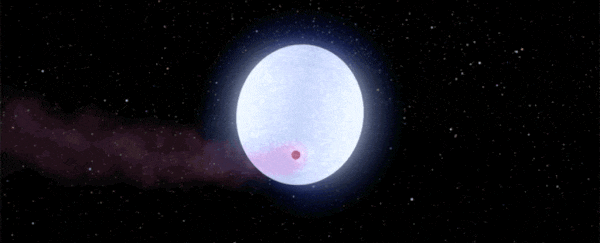A couple of years ago, astronomers marvelled over the discovery of the hottest planet in the known Universe. And just when you thought KELT-9b couldn't get even more insane, it goes and outdoes itself.
New research shows that not only is this planet hotter than most stars, with vaporised iron and rare Earth metals in its atmosphere, its heat is so intense that it experiences planet-wide meltdowns that tear apart the molecules in that atmosphere.
No other exoplanet we've discovered gets anywhere close to being this metal.
The discovery of KELT-9b, a tidally locked gas giant around three times the mass of Jupiter orbiting a scorching star 670 light-years away, was announced in 2016. But it wasn't until the following year that its extreme temperature was revealed.
It clocked in at an utterly jaw-dropping 4,300 degrees Celsius (7,800 degrees Fahrenheit) on its day side - a temperature that is "hotter than at least 80 percent of all known stars," as astronomer Jonti Horner from the University of Southern Queensland told ScienceAlert.
It's classified as an ultra-hot Jupiter, and it's the hottest planet astronomers have ever identified. It's orbiting its star, a blue supergiant called HD 195689 that burns at temperatures around 9,900 degrees Celsius (17,850 degrees Fahrenheit). And the more we look at it, the wilder it gets.
The latest discovery, made using observations from the just-retired Spitzer Space Telescope, is a doozy.
Astronomers have found that the day side is so hot that not even hydrogen molecules can hold themselves together. They're shredded apart into their constituent atoms, and can only recombine in the relative coolness of around 2,300 degrees Celsius (4,170 degrees Fahrenheit) on the planet's night side.
This is called hydrogen dissociation and recombination, and it's not dissimilar to a previously discovered atmospheric process on ultra-hot Jupiters. In 2018, astronomers discovered that the intense heat on this class of planets also tears apart water molecules, as well as titanium oxide and aluminium oxide.
And, although KELT-9b is in a class of its own, hydrogen dissociation and recombination should occur on cooler planets, too.
"This kind of planet is so extreme in temperature, it is a bit separate from a lot of other exoplanets," said planetary scientist Megan Mansfield of the University of Chicago.
"There are some other hot Jupiters and ultra-hot Jupiters that are not quite as hot but still warm enough that this effect should be taking place."
Spitzer was an infrared instrument, which means it could measure thermal radiation - heat. The team used this capability to carefully study the planet as it orbits the star, creating a temperature profile.
The star's orbit is extremely tight - just 1.48 days. (Amazingly, there are gas giants with even closer orbits, but none around stars as hot as HD 195689.)
At these proximities, planets are always tidally locked, with one side permanently facing the star, and the other in eternal night.
But the atmosphere can still move around. And that, the researchers found, is likely why the night side of KELT-9b isn't cooler than it is - because the atmosphere distributes the temperature as it moves around the planet.
There are other possible explanations; "If you don't account for hydrogen dissociation, you get really fast winds of 60 kilometres (37 miles) per second," Mansfield said. "That's probably not likely."
In addition, hydrogen dissociation and recombination can explain other observations of ultra-hot Jupiters. For instance, the process would likely produce the negative ions of hydrogen that are thought to give these planets their opacity.
It's an interesting result, but the observations also showed that we're far from done with KELT-9b's mysteries. Tidally locked planets have a hotspot, which in KELT-9b should have been at the substellar point, directly facing the star. It was, instead, offset.
Although in other hot Jupiters, this offset seems to have been produced by superrotating atmospheric jets transferring heat asymmetrically, the exact cause has yet to be determined for KELT-9b. Stay tuned.
The research has been published in The Astrophysical Journal Letters.
